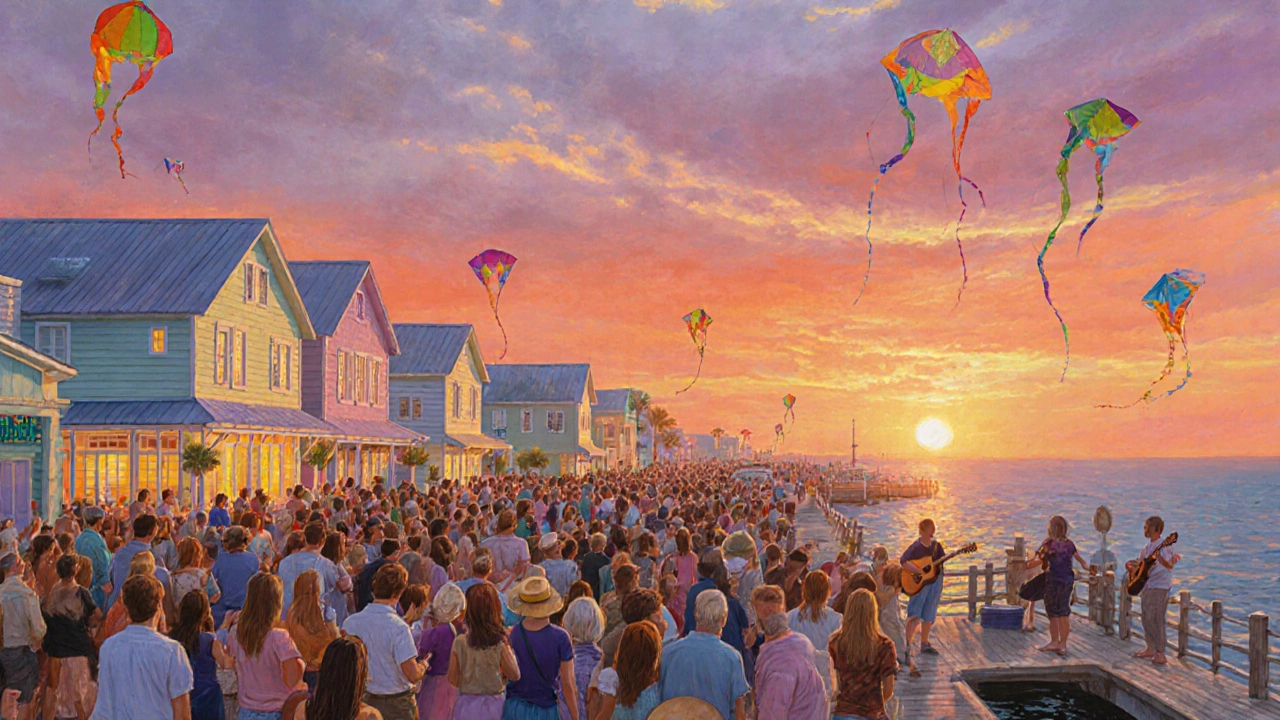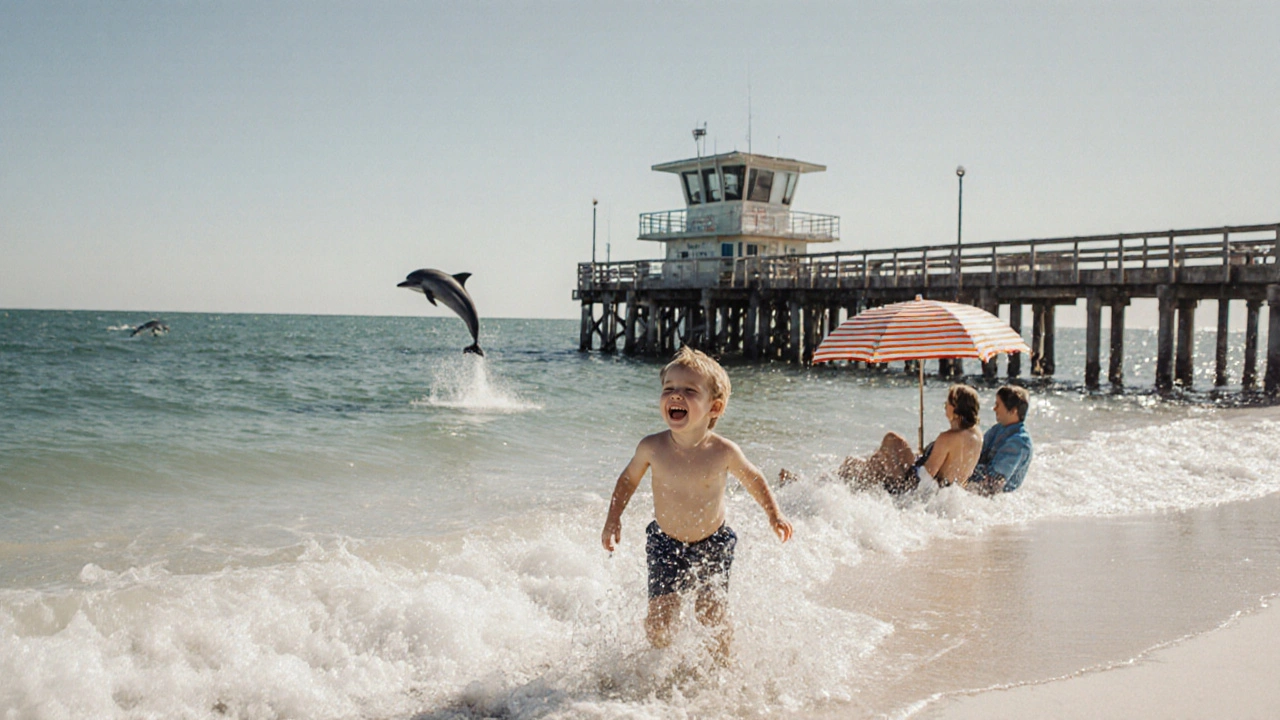When people ask what the nicest area of Florida is, they’re not just looking for a pretty beach or a postcard sunset. They want a place that feels alive-where the air smells like salt and orange blossoms, where you can walk barefoot on sand that doesn’t burn your feet, and where locals actually smile back when you say hello. Florida has over 1,200 miles of coastline and dozens of towns that all claim to be the best. But not all are created equal. Some are packed with tourists, overpriced, and feel like theme park parking lots. Others? They keep their charm, even as the world changes around them.
Sanibel Island: Where the shells outnumber the people
Sanibel Island, off Florida’s Gulf Coast, isn’t flashy. There are no high-rises. No neon signs. No lines for ice cream. What it has is some of the best shelling in the world. The island curves just right to catch shells washed in from the Gulf-cockle shells, scallops, sand dollars. Locals know the best time to hunt: two hours after low tide. You’ll see families with buckets, retirees with hats, and kids with wide eyes picking up treasures.
The beaches here are wide, soft, and rarely crowded. The water is calm and shallow, perfect for wading. Sanibel has a strict building code: no structure can be taller than a palm tree. That’s why it still feels like the Florida of the 1970s. The island is car-free in parts, with bike paths winding through mangroves and past fishing shacks. If you want peace, quiet, and nature that doesn’t need a ticket to enter, Sanibel is it.
Key West: Where the sun sets on the ocean, not the horizon
Key West is the southernmost point in the continental U.S. It’s also one of the most colorful. The pastel houses, the street musicians playing reggae on Duval Street, the old Conch houses with wraparound porches-it all adds up to a vibe you won’t find anywhere else in Florida.
Every evening, hundreds of people gather at Mallory Square for the Sunset Celebration. It’s not just a view-it’s a ritual. Street performers, local artists, and live music turn the sunset into a party. And yes, it’s touristy. But it’s touristy in a way that feels authentic. The history is real: Ernest Hemingway lived here. Truman Truman once used it as a winter retreat. The lighthouse still guides boats, and the Conch people? They’ve lived here for generations.
Key West isn’t for everyone. It’s loud at night. The prices are steep. But if you want a place with soul, history, and a little bit of magic, it’s hard to beat.
Clearwater Beach: Family-friendly perfection
Clearwater Beach is what most people picture when they think of Florida’s Gulf Coast. White sand. Turquoise water. Palms swaying. It’s clean, safe, and designed for families. The beach is consistently ranked among the top 10 in the U.S. by TripAdvisor and Travel + Leisure.
The pier here has a free aquarium, a snack bar, and a boardwalk with games and ice cream stands. The water is calm enough for toddlers to splash without fear. Lifeguards are on duty year-round. There are public restrooms, shaded picnic areas, and bike rentals that cost less than $10 an hour.
And then there’s the dolphin watching. Boat tours leave daily from the beach, and most come back with photos of dolphins riding the bow wave. One local guide told me he’s seen the same pod for 17 years-they know the boat, and they know the route. That’s not something you can fake.

St. Augustine: The oldest city in America
St. Augustine isn’t just old-it’s the oldest continuously inhabited European-established settlement in the continental U.S., founded in 1565. Walking its cobblestone streets feels like stepping into a living museum. But it’s not a ghost town. There are cafés with fresh key lime pie, art galleries in restored Spanish colonial buildings, and live jazz on weekend nights.
The Castillo de San Marcos, a 17th-century stone fortress, is the oldest masonry fort in the country. You can walk its ramparts and see where Spanish soldiers once kept watch over the harbor. At night, the city lights up with ghost tours and lantern-lit walks through the old quarter. Locals say the ghosts are friendly. You’ll hear laughter, not screams.
St. Augustine doesn’t have the white sand of the Gulf, but it has something rarer: time. You can feel centuries here. It’s quiet, walkable, and full of stories. If you want Florida with depth-not just sunburn and souvenirs-this is the place.
Destin: Where the water looks like it’s been photoshopped
Destin is famous for its sand. It’s not just white-it’s almost glittering. That’s because it’s made of pure quartz, washed down from the Appalachian Mountains over thousands of years. The result? Water so clear you can see your toes 10 feet down.
The beaches here are wide and open. The Gulf is calm, and the water temperature stays warm well into fall. Destin is a fishing town at heart. The harbor is packed with charter boats. You can book a half-day trip for $75 and catch grouper, snapper, or even a tarpon. The catch-and-release culture is strong here. Locals don’t just fish-they protect the water.
Destin has more restaurants per capita than most Florida towns. Fresh seafood, flown in daily from the harbor. You’ll find shrimp tacos, grilled mahi-mahi, and stone crab claws. And the sunset views? They’re worth staying for. No crowds. No noise. Just the sound of waves and a sky turning gold.
What makes an area truly "nice"?
There’s no single answer. The nicest area of Florida depends on what you’re looking for.
If you want peace and nature, go to Sanibel. If you want history and charm, choose St. Augustine. If you’re with kids, Clearwater Beach wins. If you crave nightlife and color, Key West is your spot. If crystal-clear water and fishing are your priorities, Destin delivers.
What all these places have in common? They didn’t sell their soul to tourism. They kept their rhythm. They still have local grocery stores, family-run diners, and fishermen who know the tides better than their own birthdays.
Florida’s best areas aren’t the ones with the most billboards. They’re the ones where you can sit on a bench at dusk, listen to the crickets, and feel like you’ve found a secret.

Where to stay without getting ripped off
Prices in Florida can spike fast-especially in summer and around holidays. Here’s how to avoid overpaying:
- Book outside peak season: Late April to early June and September to early November are quiet, warm, and cheaper.
- Stay in a vacation rental near the beach, not directly on it. You’ll save 30-50% and still walk to the sand in 5 minutes.
- Use local booking sites like Florida Vacation Rentals or Visit Florida’s official partners. Avoid big platforms that charge hidden fees.
- Check for free parking. Many beach towns charge $15-$30 per day to park near the sand.
Pro tip: Ask locals where they eat. If a restaurant has a line of cars with Florida plates, it’s probably good.
What to avoid
Not all Florida spots live up to the hype. Here’s what to skip:
- Daytona Beach during Spring Break-too loud, too crowded, too much trash.
- Orlando’s tourist corridors like International Drive-overpriced, repetitive, and soulless.
- South Beach in Miami after dark-great for parties, but not for relaxation or safety.
- Any place that charges $25 for a single bottle of water. That’s not Florida. That’s a trap.
Florida’s magic isn’t in the resorts. It’s in the quiet corners, the hidden paths, the local seafood shacks with no signs. Find those, and you’ll find the real Florida.
Is there a single best beach in Florida?
There’s no single "best" beach-it depends on what you want. For clear water and soft sand, Destin and Clearwater lead. For shelling, Sanibel is unmatched. For a lively vibe with history, Siesta Key and St. Augustine’s beaches stand out. Each has its own personality. The best beach is the one that matches your mood.
What’s the cheapest nice area to visit in Florida?
St. Augustine and Panama City Beach offer the best value. You can find clean, well-rated vacation rentals for under $120 a night in the off-season. Both have free public beaches, historic sites to explore without admission fees, and local eateries where a full seafood plate costs under $20. Avoid tourist traps near Disney and Miami Beach if you’re budgeting.
Is Florida safe for families?
Yes, if you pick the right areas. Sanibel, Clearwater, St. Augustine, and Destin have low crime rates and family-friendly infrastructure. Beaches have lifeguards, towns have walkable streets, and most resorts offer kid-friendly activities. Avoid high-density areas like South Beach at night, and always lock your car. But overall, Florida is one of the safest states for family travel.
When is the best time to visit Florida?
The sweet spot is late April to early June, and September to early November. The weather is warm but not sweltering, crowds are thin, and prices drop by 30-40%. Hurricane season runs June to November, but most storms miss the popular tourist zones. Just check forecasts before you go. Winter is great too, but it’s peak season-book early.
Can you see wildlife in Florida’s nicest areas?
Absolutely. Sanibel and Captiva islands are famous for dolphins, manatees, and shorebirds. In Clearwater, you can join a dolphin-watching tour. St. Augustine has alligators in the nearby marshes, and you’ll often see herons and egrets along the boardwalks. Destin’s waters are home to sea turtles, especially in spring. Just keep your distance-wildlife is protected, and feeding animals is illegal.
Final thought: The real Florida isn’t on a postcard
The nicest area of Florida isn’t the one with the most Instagram likes. It’s the one where you forget to check your phone. Where you eat fresh shrimp off a plastic table under a tarp. Where you hear a local say, "You’re here just in time-this is our favorite time of year."
Florida’s beauty isn’t in its resorts. It’s in its rhythm. In the slow pace of a Gulf Coast sunset. In the quiet of a shell-strewn beach at dawn. In the way a stranger offers you a cold drink because you look tired.
Find that, and you’ve found the real Florida.

